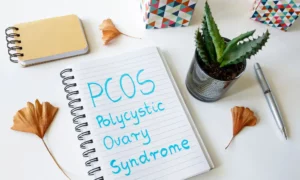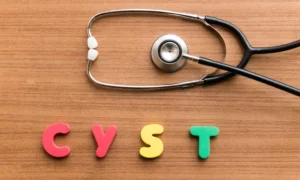PCOD, or Polycystic Ovary Syndrome, is a common yet complex condition affecting the reproductive system in women. Understanding the intricacies of Polycystic Ovarian Disease is crucial for those diagnosed and those around them. Let’s delve into the various aspects of PCOD, from its causes and symptoms to diagnosis, treatment, and lifestyle management.
Contents
Understanding PCOD 
PCOD, or Polycystic Ovarian Disease, primarily results from a combination of hormonal imbalance and genetic predisposition. In a typical menstrual cycle, the ovaries alternately release mature eggs that are ready for fertilization. However, individuals with PCOD often experience the release of either immature or partially mature eggs, which can develop into cysts—small sacs filled with fluid.
This process leads to the swelling and enlargement of the ovaries. Normally, a limited amount of androgens (male hormones) is released by the ovaries during the cycle. In the case of Polycystic Ovarian Disease, there is an excess production of androgens, resulting in symptoms such as male-pattern hair loss, abdominal weight gain, irregular periods, and, in severe cases, infertility.
What Are The Causes Of PCOD?
The exact causes of Polycystic Ovary Syndrome (PCOD) are not fully understood, but it is generally believed to result from a combination of genetic and environmental factors. Here are some factors that may contribute to the development of PCOD:
- Genetics
There appears to be a hereditary component to Polycystic Ovarian Disease. If a woman has a family history of PCOD, her risk of developing the condition may be higher. - Hormonal Imbalance
PCOD is associated with an imbalance in sex hormones, particularly elevated levels of androgens (male hormones) and insulin. This hormonal imbalance can disrupt the normal menstrual cycle and lead to the characteristic symptoms of PCOD. - Insulin Resistance
Many individuals with PCOD have insulin resistance, where the body’s cells do not respond effectively to insulin. Insulin resistance can lead to an overproduction of insulin, which in turn may contribute to the elevated androgen levels seen in PCOD. - Inflammation
Chronic inflammation may play a role in the development of Polycystic Ovarian Disease. Inflammation can affect the ovaries and interfere with normal ovarian function. - Lifestyle Factors
Poor lifestyle choices, such as a sedentary lifestyle and an unhealthy diet, may contribute to the development and exacerbation of PCOD symptoms. Maintaining a healthy lifestyle through regular exercise and a balanced diet can help manage PCOD.
It’s important to note that PCOD is a complex and heterogeneous condition, and the combination of factors contributing to its development may vary among individuals. Additionally, the presence of polycystic ovaries does not necessarily indicate the presence of PCOD, as ovarian cysts can be a normal part of the menstrual cycle in some cases. Consultation with a healthcare professional is crucial for accurate diagnosis and appropriate management of Polycystic Ovarian Disease.
Symptoms Of PCOD 
Polycystic Ovary Syndrome (PCOD) can manifest with a variety of symptoms, and the severity and combination of symptoms can vary among individuals. Common symptoms of PCOD include:
- Irregular Menstrual Cycles
Women with PCOD often experience irregular periods. This may include infrequent periods, prolonged periods, or unpredictable cycles. - Ovulatory Dysfunction
PCOD can cause problems with ovulation or the release of mature eggs from the ovaries, leading to difficulties in achieving pregnancy. - Cyst Formation
The presence of small fluid-filled sacs or cysts on the ovaries is detected through ultrasound imaging. However, not all individuals with PCOD have cysts, and not all cysts indicate PCOD. - Androgen-related Symptoms
Elevated levels of androgens (male hormones) can lead to symptoms such as:- Hirsutism: Excessive hair growth on the face, chest, back, or other areas where men typically grow hair.
- Acne: Increased likelihood of acne and oily skin.
- Male-pattern Hair Loss: Thinning of hair on the scalp, similar to male-pattern baldness.
- Weight Gain
Many individuals with Polycystic Ovarian Disease experience weight gain, especially around the abdomen, which can be challenging to manage. - Insulin Resistance
PCOD is associated with insulin resistance, which can contribute to difficulties in maintaining a healthy weight and an increased risk of type 2 diabetes. - Skin Changes
Darkening of the skin, particularly in body creases like the neck, groin, and under the breasts. This is known as acanthosis nigricans. - Mood Changes
Some individuals with PCOD may experience mood swings, anxiety, or depression.
It’s important to note that not all individuals with PCOD will experience all of these symptoms, and the severity of symptoms can vary. Additionally, some symptoms, like irregular periods and cyst formation, can also be part of other health conditions. If someone suspects they have PCOD, it is advisable to consult with a healthcare professional for proper diagnosis and guidance on management.
Difference Between PCOD And PCOS
The terms PCOD (Polycystic Ovarian Disease) and PCOS (Polycystic Ovary Syndrome) are often used interchangeably, but they represent different aspects of the same condition. Let’s delve into the details of the differences between PCOD and PCOS:
- Definitions
PCOD (Polycystic Ovarian Disease): PCOD is primarily focused on the physical presence of cysts on the ovaries. It denotes ovaries with multiple small cysts.
PCOS (Polycystic Ovary Syndrome): PCOS is a broader and more comprehensive term. It not only includes the presence of ovarian cysts but also encompasses the associated hormonal and metabolic disturbances, along with various symptoms.
- Scope
PCOD: The term PCOD may be used in a more anatomical sense, referring specifically to the ovaries having cysts.
PCOS: PCOS is a syndrome, implying a collection of symptoms that go beyond just the physical presence of cysts. It involves hormonal imbalances, insulin resistance, and potential metabolic issues.
- Diagnostic Criteria
PCOD: Diagnosis of PCOD is primarily based on the observation of cysts on the ovaries through ultrasound imaging.
PCOS: Diagnosis of PCOS is more comprehensive and may involve multiple criteria. Common diagnostic criteria include irregular menstrual cycles, elevated levels of androgens (male hormones), and the exclusion of other conditions that could mimic PCOS symptoms.
- Treatment and Management
PCOD: Management of Polycystic Ovarian Disease might focus on addressing symptoms related to ovarian cysts, and treatment may vary based on individual needs.
PCOS: Treatment for PCOS is more holistic, addressing hormonal imbalances, insulin resistance, and specific symptoms. Lifestyle modifications, such as diet and exercise, may be emphasized.
Therefore, PCOD specifically refers to the presence of cysts on the ovaries, PCOS is a more encompassing term that includes both the ovarian cysts and the associated hormonal and metabolic abnormalities.
What Are The Treatment Options For PCOD? 
Polycystic Ovary Syndrome (PCOS) is a common hormonal disorder affecting individuals of reproductive age, particularly women. The treatment of PCOS aims to manage symptoms and address underlying hormonal imbalances. Here are some common treatment options:
- Lifestyle Modifications
- Dietary Changes: A balanced and healthy diet is essential. Focus on whole foods, lean proteins, fruits, vegetables, and whole grains. Limit refined carbohydrates and sugars.
- Regular Exercise: Physical activity helps improve insulin sensitivity and can aid in weight management, which is crucial for PCOS patients.
- Medications
- Birth Control Pills: Oral contraceptives can regulate menstrual cycles and reduce androgen levels.
- Anti-Androgen Medications: Drugs like spironolactone can help reduce symptoms such as acne and excess hair growth.
- Metformin: Often prescribed for women with PCOS who have insulin resistance, as it helps regulate blood sugar levels.
- Fertility Treatments
- Clomiphene Citrate: This medication can induce ovulation in women trying to conceive.
- Letrozole: Another medication used to stimulate ovulation in women with PCOS.
- Weight Management
- Achieving and maintaining a healthy weight can significantly improve symptoms and regulate menstrual cycles.
- Nutritional Supplements
- Some women with PCOS may benefit from supplements like inositol, particularly myo-inositol, which can help improve insulin sensitivity.
- Surgery
- In some cases, a minor surgical procedure called ovarian drilling may be considered to stimulate ovulation.
- Behavioural Therapy
- Counseling or therapy may help manage stress and emotional well-being, as stress can exacerbate PCOS symptoms.
It’s important to note that the specific treatment plan varies based on individual symptoms, medical history, and the goals of the patient (e.g., managing symptoms, and improving fertility). Consultation with a healthcare professional, preferably a gynecologist or endocrinologist, is crucial for personalized advice and treatment planning.
Conclusion
In conclusion, Polycystic Ovarian Disease is a multifaceted condition that requires a comprehensive approach for effective management. From medical interventions and lifestyle modifications to emotional well-being and ongoing research, addressing Polycystic Ovarian Disease involves a combination of strategies tailored to individual needs.
If you are facing PCOS-related issues, PCOS treatment at HerMantra can help. Book your free trial online pcos treatment session now.





